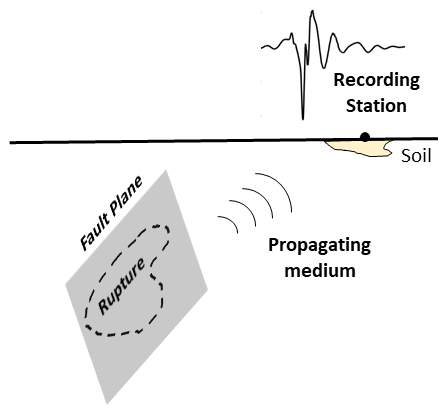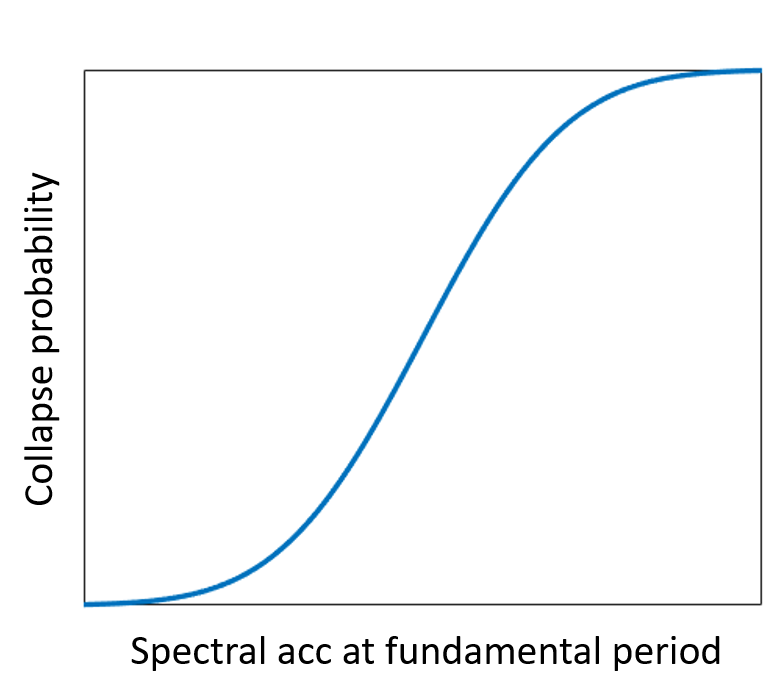Earthquake Process. An earthquake is a complex process involving three main events: 1. rupture on the fault plane and generation of seismic waves (source); 2. seismic wave propagation (path); 3. ground motion on the surface (site). These three events associated with earthquakes are depcited in the figure below.

Accelerograms and Scaling. Whenever an earthquake occurs, instruments called accelerometers spread across on the earth’s surface record the ground motion. This recorded motion is typically called an accelerogram since it is a plot of ground acceleration versus time. Accelerogram scaling, as it is practiced in Earthquake Engineering, involves scaling the amplitudes of a recorded accelerogram so as to intensify it. The below figure demonstrates this scaling procedure, wherein one of the 1994 Northridge accelerograms is scaled up five times. The scaled accelerogram is noted to have increased amplitudes than the unscaled one; however, the time variation of both these accelerograms is exactly the same.
Why Scale Accelerograms? Earthquake engineers have to assess the safety and reliability of buildings, bridges, and other infrastructure during strong earthquakes. Earthquakes which have large magnitudes and which happen at small distances from infrastructure can be characterized as being strong. Accelerogram recordings from such strong earthquakes are scarce. For example, the fraction of magnitude greater than 6.5 and distance less than 20Km accelerograms in the NGA-West2 ground motion database is less than ten percent. Owing to this scarcity of strong recorded accelerograms and the necessity of engineers to assess infrastructure earthquake performance, accelerograms are scaled.
Use of Scaled Accelerograms. Scaled accelerograms are used for two main purposes: 1. ground motion selection; 2. structural response analysis. In ground motion selection, accelerograms are scaled so that they match a target response spectrum such as the ASCE 7-16 design spectrum or the Conditional Mean Spectrum. The figure below towards the left presents a suite of scaled accelerograms in Orange matched to a target response spectrum in Blue. Once accelerograms are scaled and matched, they are then used to study the response of structural models. Accelerogram scaling is also used for structural damage and collapse analysis using procedures such as Incremental Dynamic Analysis and Multiple Stripe Analysis. In those analysis procedures, accelerograms are scaled so that their intensities at an oscillator period (typically the fundamental structural period) match a design intensity level obtained from seismic hazard analysis. These scaled accelerograms are then used for seismic response analysis to quantify the probability of damage or collapse of structures given the intesity level. The figure below towards the right presents a collapse fragiltiy curve of a building obtained using Incremental Dynamic Analysis with earthquake intensity (in terms of spectral acceleration at the fundamental period) on the x-axis and the collapse probability on the y-axis.

Ubiquity of Scaling Accelerograms. Because of the scarcity of strong recorded accelerograms and the lack of enough accelerograms whose spectral shapes match a target response spectrum, accelerogram scaling is commonly practiced in Earthquake Engineering. Procedures such as the Incremental Dynamic Analysis, frequently employed in seimsic analysis, rely upon accelerogram scaling. Having said this, and on the flip side, it should be noted that there are quite a number of studies which perform seismic analysis of structures without scaling accelerograms. This study is one example, wherein, fragility assessments of buildings were conducted using unscaled accelerograms.
Accelerogram Scaling Physics is Less Understood. Although scaling accelerograms is quite ubiquitous in Earthquake Engineering analysis, the physics and the underlying priciples of scaling are less understood. Or in other words, the seismic properties of scaled accelerograms–in terms of their magnitudes, distances, and other seismic parameters–, to the best of the author’s knowledge, are not established. Determining such seismic properties of scaled accelerograms is important because: this would then allow engineers to compare seismic parameters of scaled accelerograms with empirical observations. Such comparison would further allow for ascertaining the seismological bias in seismic response analysis and also allow the development of scaling procedures which obey seismic laws/observations. While some studies (such as this) have investigated the bias in scaling accelerograms by comparing response reuslts of unscaled and scaled accelerograms, the applicability of the recommendations made by such studies, if any, are very limited and subjective.
Note: In the previous paragraph, assertions on using the seismic properties of scaled accelerograms to investigate the bias in seismic response analysis will be supported by examples towards the end of this series of blog posts.
To cite this page: Dhulipala, S.L.N. (2018) What is the Seismology of Accelerogram Amplitude Scaling? (in review)

This work is licensed under a Creative Commons Attribution-NonCommercial 4.0 International License.